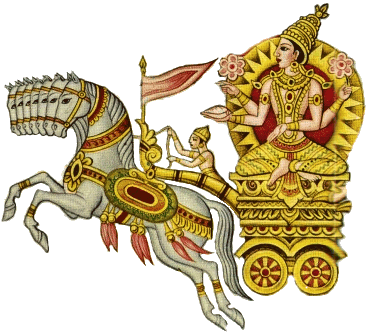गुरुः शुक्रः शनी राहुः केतुश्चैते यथाक्रमम्॥ १०॥
atha kheṭā raviścandro maṅgalaśca budhastathā |
guruḥ śukraḥ śanī rāhuḥ ketuścaite yathākramam || 10||
Translation: The kheṭa [graha, planets] are ravi [Sun], chandra [Moon], maṅgala [Mars] budha [Mercury], guru [Jupiter], śukra [Venus], śani [Saturn], rāhu [north node] and ketu [south node], in order.
The Order
The order being referred to is the order of Agni the lord of bhū-loka. In this order the first place is given to the Sun which is the source of all agni. By implication there should be at least four other order of planets for the other four tattva – jala, vāyu, pṛthvi and ākāśa. But the most important is always the agni order since agni rules bhū-loka. This is pronounced in the mantras –

om bhūr-agnaye namaḥ
This mantra extolls Agni-deva as the lord of bhū-loka.

ॐ भुवोर्सूर्याय नमः
om bhuvorsūryāya namaḥ
This mantra extolls Sūrya-deva as the lord of bhuva-loka

ॐ स्वरिन्द्राय नमः
om svarindrāya namaḥ
This mantra extolls Indra-deva as the lord of Svarga-loka
Our external (visible) body is divided into three parts.

Agni-MAṆḌALA
The lower part below the hip (from hip-thigh joint) to the bottom of the feet, is the agni maṇḍala with Agni as the lord. It maps to bhū-loka which is the earth-moon plane. Mars is the significator of Agni and is also the king of the maṇḍala. The Sanskrit word used is kāraka implying the power of god to act.
The chief graha functioning directly in this plane is the Moon, which becomes the populator or kāraka. All souls enter and exit bhū-loka only at the discretion of the Moon. The Moon has two doorways – the north door called Rāhu and the south door called Ketu. These two doors are listed after the seven weekday planets thereby making the ‘navagraha’ order.
Sūrya Maṇḍala
The torso from the hip region to the neck, is the sūrya maṇḍala with Sūrya as the lord. This maps to bhuva-loka and antarikṣa. The karaka for this sūrya maṇḍala is Sūrya. Bhuva loka indicates the solar system and includes all the navagraha. However, we must exclude the three that are in bhū-loka namely Moon, Rāhu, Ketu. The remaining visible planets are Sun, Mercury, Venus, Mars, Jupiter and Saturn. The word visible means visibility for naked eye. Of the six remaining, the Sun and ‘inner planets’ Mercury and Venus are assigned to bhuva-loka. The Sun creates the twelve-sign zodiac at the center at the navel for the graha to be assigned karma. He ties the rope (umbilicus) for the soul to sit in the boat (body) and arrive on earth.
Soma Maṇḍala
The head from the neck to the tip and above, is the soma maṇḍala. Soma is the elixir of the gods, the nectar of immortality which keeps the devatā alive. This maṇḍala maps to svarga loka with Indra as the devatā controlling all live experience through the ten-indriya working in the body and thoughts moving in the ten-directions. Venus is the king of svarga loka which offers great comfort and pleasure activities.
The remaining three are the outer planets Mars, Jupiter and Saturn which are assigned to the svarga loka.
Agni Tattva
Agni tattva manifests as heat and light based on the solar source. Heat is signified by Mars and manifests within us as strength, anger and in various other ways; light is signified by the Sun and manifests within us as insight, leaning and knowledge.
The ability to tame fire is what made man the king of this planet, else by all counts we should have been slaves to lions and tigers or pushed around by the elephants.
Webinar
We learn more about all this in the webinar for this lesson …stay tuned















